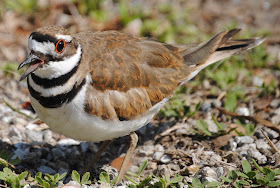The Eastern Amberwing Dragonfly (Perithemis tenera) is a small and very wary specimen found near fresh water ponds in the Eastern U.S. The males have amber wings....the female's wings have brown spots. Both have reddish pterostigma. Above is a male.
The scientific name, tenera, means "delicate" and alludes to it's small size....the second smallest dragonfly in North America. The smallest being the Elfin Skimmer.
Here is a female with brown wing spots. These photos were taken on Gasparilla Island, Florida. The Amberwings were resting on Sea Grape trees (Coccoloba uvifrea).
An interesting behavior for this small, stubby dragonfly is it's imitation of a wasp. Here is the posture it uses to fool potential predators. Birds may well predate on small dragonflies, but don't wish to tangle with a 25mm wasp!







